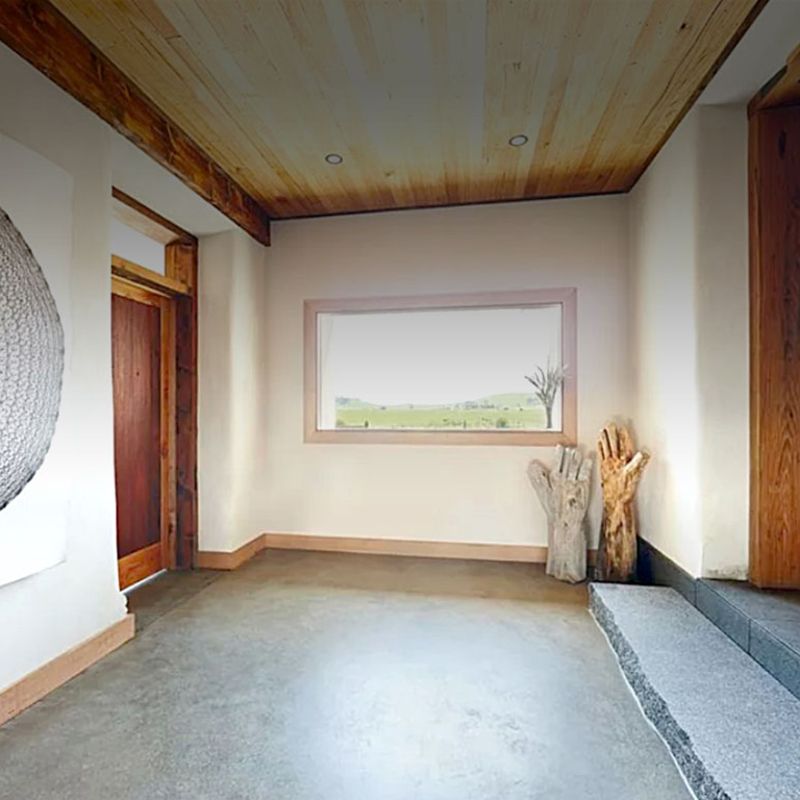
10 Types of Concrete Finishes
1. Troweled Finish
Once the freshly poured concrete has been smoothed over using a screed, a fine finish may be achieved by using a trowel. The task may be completed manually or mechanically.
The blade of a hand trowel is flat and attached to a handle. A combination of pulling and pushing motions is required to move the blade over the concrete. The worker repeats this action until the surface is even and smooth.
Power trowels are used in more extensive operations, notably industrial and commercial construction. They resemble stationary fans made of blades and are installed on the ground.
2. Broom Finish (Brushed Finish)
A broom finish on concrete is just the next step following a trowel finish. After the concrete surface has been levelled, troweling or another analogous smoothing operation is employed to “seal” it. Following that, the personnel pull a specialised broom over the floor.
The drag roughens the surface more than troweling alone would. This enhances the region’s attractiveness and makes it less slippery in the rain. Both trowel and brush treatments need aggregate sand and rock.
3. Stamped Concrete Finish
There are several attractive concrete finishes to choose from. Stamped concrete is one of the best processes to create fascinating patterns and textures. Laying pattern panels on uncured cement gives it a stamped concrete finish. This imbues the concrete with the design of the panel.
Concrete stamps are available in many styles. This category includes stone, brick, tile, and other patterned materials.
4. Salt Finish Concrete
In moist environments like swimming pools, a salt finish concrete surface is often utilised to protect the concrete from the elements. This finish is achieved by sprinkling coarse rock salt crystals over wet (uncured) concrete. After the rock salt has been rinsed into the ground, it will create a highly textured, slip-resistant surface in the concrete.
5. Exposed Aggregate Finished Concrete
The aggregates used to form the concrete are ground back and become visible in an exposed aggregate finish. Unlike other finishes where the stones are hardly discernible, the aggregates used in this one are often chosen for their aesthetic appeal.
Washing away the top layer of cement exposes the aggregate underneath, resulting in an exposed aggregate finished concrete floor. Aggregates may be made from stones, seashells, glass, granite, and other hard materials.
Concrete mix is poured, levelled, and then troweled to achieve this distinct look. The next day, a chemical is employed to postpone the setting of the surface cement. The surface is then thoroughly cleaned with water to remove the top layer and show the aggregate underneath.
The polishing technique for exposed aggregate concrete ensures a non-slip surface. This makes it both visually beautiful and functional. It is an excellent material for walkways, porches, and breezeways.
6. Polished Finish
Cured concrete may be given a polished appearance for increased durability, ease of maintenance, and aesthetic appeal. To achieve a shiny, professional finish, concrete floors are often ground down using specialised floor grinders to attain a smooth surface.
These floor grinders use a grinding disc studded with tough diamond abrasives. The abrasives on the various discs range in grit size from fine to coarse. While coarse abrasives leave a rougher finish, fine abrasives leave smoother concrete surfaces.
At this stage, chemical hardeners are occasionally used in concrete to prevent water damage. After grinding, the product may be sealed on the inside or outside to protect it against chemicals, oil, and stains.
7. Epoxy Finish
Epoxy finish is a versatile solution that is practical, long-lasting, exceptionally impact-resistant, and adaptable to any environment. There’s an epoxy coating for your restaurant’s entrance or your factory’s heavy foot traffic.
Epoxy, the most durable concrete finish, may be poured into surface irregularities to smooth them out and produce a uniform surface. However, you may make a concrete floor more appealing by applying epoxy, which comes in various colours and can be readily customised.
8. Colored Finish
Integral Colouration
Colour Hardener
Dyeing
The colours achieved by using concrete dyes are the brightest of all approaches. Choose from five colours: red, orange, yellow, purple, and blue. Because dyes generate such vibrant hues, a mock-up from your contractor is a must to ensure satisfaction with the final product.
9. Swirl Finish
With an evenly overlapping circular pattern, the concrete surface is smeared to create a swirl finish, one of the most distinctive styles of concrete finish. It makes the concrete surface seem likable and is a great architectural accent.
This sort of finish is prefered for outdoor concrete projects since it not only improves the aesthetics of the surface but also makes it more slip-resistant when wet, making it safer to walk and stand on.
10. Stained Concrete Finish
Stained concrete is concrete that has had its surface smoothed and curing processes completed. Colour is then applied to the top, staining the concrete. However, although most concrete stains are muted or earthy tones, a wide variety of hues are available.
With the right stain, even plain concrete may seem elegant and sophisticated. Although these stains are suitable for use on older concrete, their rich colours and durability are best experienced when applied to freshly poured or resurfaced slabs.
